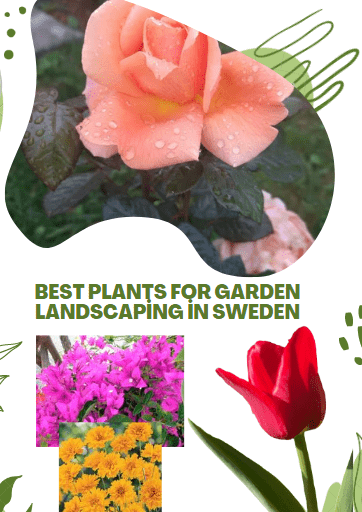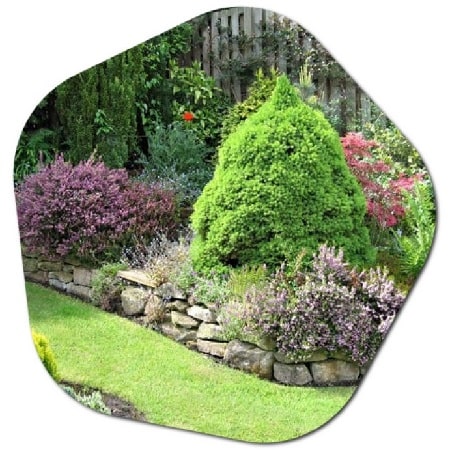The best plants for garden landscaping in Sweden
Garden landscaping in Sweden presents unique challenges due to the country’s varying climate, with cold winters and relatively short growing seasons. However, there is a wide range of beautiful plants that can thrive in Swedish gardens. Here are some of the best plant choices for garden landscaping in Sweden:
- Native Plants:
- Choosing native plants is an excellent strategy, as they are adapted to Sweden’s climate and conditions. Some native Swedish plants include:
- Wood Anemone (Anemone nemorosa)
- Wood Cranesbill (Geranium sylvaticum)
- Harebell (Campanula rotundifolia)
- Choosing native plants is an excellent strategy, as they are adapted to Sweden’s climate and conditions. Some native Swedish plants include:
- Perennials:
- Perennial plants come back year after year and are ideal for Swedish gardens. Consider these options:
- Lupines (Lupinus spp.)
- Coneflowers (Echinacea spp.)
- Hostas (Hosta spp.)
- Daylilies (Hemerocallis spp.)
- Bleeding Heart (Dicentra spectabilis)
- Perennial plants come back year after year and are ideal for Swedish gardens. Consider these options:
- Shrubs:
- Shrubs add structure and color to your garden. Some suitable choices for Swedish gardens include:
- Lilac (Syringa vulgaris)
- Spirea (Spiraea spp.)
- Rose of Sharon (Hibiscus syriacus)
- Hydrangea (Hydrangea spp.)
- Shrubs add structure and color to your garden. Some suitable choices for Swedish gardens include:
- Trees:
- Trees provide shade and vertical interest. Opt for trees like:
- Silver Birch (Betula pendula)
- Swedish Whitebeam (Sorbus intermedia)
- Scots Pine (Pinus sylvestris)
- Rowan (Sorbus aucuparia)
- Trees provide shade and vertical interest. Opt for trees like:
- Ground Covers:
- Ground covers help suppress weeds and create a lush look. Consider plants such as:
- Alchemilla (Alchemilla spp.)
- Creeping Jenny (Lysimachia nummularia)
- Thyme (Thymus spp.)
- Ground covers help suppress weeds and create a lush look. Consider plants such as:
- Annuals:
- Use annual flowers to add seasonal color. Some options for Swedish gardens include:
- Marigolds (Tagetes spp.)
- Cosmos (Cosmos bipinnatus)
- Zinnias (Zinnia spp.)
- Nasturtiums (Tropaeolum majus)
- Use annual flowers to add seasonal color. Some options for Swedish gardens include:
- Herbs and Edibles:
- Integrate herbs and edible plants into your garden for both aesthetics and practicality. Some choices include:
- Rosemary (Rosmarinus officinalis)
- Basil (Ocimum basilicum)
- Strawberries (Fragaria x ananassa)
- Rhubarb (Rheum rhabarbarum)
- Integrate herbs and edible plants into your garden for both aesthetics and practicality. Some choices include:
- Bulbs:
- Spring-blooming bulbs can bring early color to your garden. Consider planting:
- Tulips (Tulipa spp.)
- Daffodils (Narcissus spp.)
- Crocuses (Crocus spp.)
- Snowdrops (Galanthus nivalis)
- Spring-blooming bulbs can bring early color to your garden. Consider planting:
- Ferns:
- Ferns thrive in shaded and damp areas. Incorporate varieties like Lady Fern (Athyrium filix-femina) and Ostrich Fern (Matteuccia struthiopteris).
- Rock Garden Plants:
- If you have rocky or alpine areas in your garden, plant rock garden favorites such as Alpine Phlox (Phlox subulata) and Alpine Aster (Aster alpinus).

Before planting, ensure your soil is well-prepared with organic matter, and consider the specific sunlight, moisture, and temperature conditions of your garden’s location in Sweden. Proper mulching, regular watering, and maintenance will help your garden flourish in Sweden’s diverse climate.
Which flowers can I plant in my garden in Sweden?
Sweden has a temperate climate with distinct seasons, and the choice of flowers for your garden will largely depend on your specific location within Sweden and the local climate conditions. However, here are some popular flowers that can generally thrive in Swedish gardens:
- Lilacs (Syringa): Lilacs are well-suited to the Swedish climate and are known for their beautiful fragrant blossoms.
- Dahlias: Dahlias come in a wide variety of colors and shapes and are a great choice for adding vibrant blooms to your garden.
- Roses: Many varieties of roses, including hardy shrub roses and climbing roses, can thrive in Sweden. They offer both beauty and fragrance.
- Tulips: Tulips are early spring bloomers and can create stunning displays of color in your garden.
- Lavender: Lavender is a fragrant herb that can add a touch of Mediterranean charm to your garden. It is drought-tolerant and does well in well-drained soil.
- Peonies: Peonies are beloved for their large, showy blossoms. They can be a lovely addition to your garden but require some care.
- Crocuses: These small, early-spring bloomers are ideal for naturalizing in lawns or under trees.
- Heather (Calluna vulgaris): Heather is a hardy, evergreen plant that adds color to your garden throughout the year.
- Lily of the Valley (Convallaria majalis): These delicate, fragrant flowers are perfect for shaded areas in your garden.
- Geraniums: Hardy geraniums, not to be confused with annual pelargoniums, are versatile perennials that thrive in Swedish gardens.
- Pansies and Violas: These cool-season annuals can provide colorful blooms in spring and fall.
- Iris: Irises come in various colors and can be a striking addition to your garden.

When selecting flowers for your garden in Sweden, consider factors such as your local climate, soil type, and the amount of sunlight your garden receives. It’s also a good idea to choose a mix of early, mid, and late-season bloomers to ensure a continuous display of flowers throughout the growing season. Additionally, pay attention to the maintenance requirements of the flowers you select, as some may need more care than others.
What season is garden landscaping in Sweden?
Garden landscaping in Sweden largely depends on the specific region within the country and the goals of your landscaping project. Sweden has a diverse climate with four distinct seasons, so the timing of your landscaping efforts may vary. Here’s a general guideline for garden landscaping in different seasons:
- Spring (April to June):
- Spring is an excellent time to start garden landscaping in most parts of Sweden, especially in the southern and central regions.
- As the snow melts and the ground thaws, you can begin planting trees, shrubs, and perennials. The soil is typically moist and workable.
- Spring-flowering bulbs like tulips and daffodils are planted in the fall but bloom in spring.
- Consider starting seeds indoors for vegetables and annuals to transplant later when the weather warms.
- Summer (July to August):
- Summer is the prime growing season in Sweden when many plants are in full bloom.
- Continue planting, but be mindful of watering, as the weather can be dry, especially in the southern and central regions.
- Focus on maintaining and enjoying your garden, including regular weeding, deadheading, and lawn care.
- Autumn (September to October):
- Early autumn is a good time for planting trees, shrubs, and perennials. The soil is still warm, allowing roots to establish before winter.
- Consider adding fall-blooming plants like asters and sedums for seasonal interest.
- Plant spring-flowering bulbs in the fall to ensure colorful blooms the following spring.
- Winter (November to March):
- Winter is not a typical season for active garden landscaping, especially in the northern parts of Sweden.
- However, you can use this time for planning, designing, and ordering seeds or plants for the upcoming spring.
- Some gardeners in the milder southern regions may still be able to work on landscaping projects during the winter months, weather permitting.
It’s essential to consider your specific location within Sweden when planning your garden landscaping activities, as the climate can vary significantly from north to south. Coastal areas, such as Stockholm and Gothenburg, tend to have milder winters and longer growing seasons compared to northern inland areas.
Before starting any landscaping project, make sure to assess local climate conditions, soil types, and plant hardiness zones specific to your region in Sweden. This will help you determine the best times for planting and landscaping activities based on your local microclimate.





